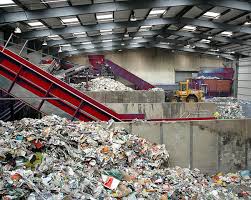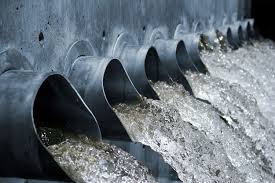The hierarchy of waste management and the concept of sustainable waste management have led to the development of alternative waste treatment and disposal options rather than the traditional reliance on the options of landfill and incineration.
Alternatives, which have a minimal environmental impact, with a view to recycling or energy recovery with low pollution, have received particular attention.
1. Pyrolysis
Pyrolysis is the thermal degradation of organic waste in the absence of oxygen to produce a carbonaceous char, oil and combustible gases. How much of each product is produced is dependent on the process conditions, particularly temperature and heating rate. The key difference is the amount of oxygen supplied to the thermal reactor.
For Pyrolysis there is an absence of oxygen, and for gasification there is a limited supply of oxygen, such that complete combustion does not take place, instead the combustible gases; carbon monoxide and hydrogen are produced.
The oxygen for gasification is supplied in the form of air, steam or pure oxygen. Incineration involves the complete oxidation of the waste in an excess supply of oxygen to produce carbon dioxide, water and ash, plus some other products such as metals, trace hydrocarbons, acid gases, etc.
2. Gasification
Gasification differs from pyrolysis in that oxygen in the form of air, steam or pure oxygen is reacted at high temperature with the available carbon in the waste to produce a gas product, ash and a tar product. Partial combustion occurs to produce heat and the reaction proceeds exothermically to produce a low to medium calorific value fuel gas.
Read Also : Advantages of Incineration of Wastes over of Landfills
The operating temperatures are relatively high compared to pyrolysis, at 800–1100°C with air gasification, and 1000–1400°C with oxygen.
3. Combined Pyrolysis-Gasification
Some modern developments in thermo-chemical processing of waste have utilized both pyrolysis and gasification in combined technologies, which may then involve a further combustion step to combust the gases produced in the first two stages.

Such pyrolysis/ gasification/combustion technologies are, in effect, incinerators, but each step is separated into a separate temperature and pressure-controlled reactor rather than in an incinerator, where the three thermal degradation steps are combined in a one-step grate (furnace) combustion system.
4. Anaerobic Digestion
The anaerobic degradation processes found in landfills which lead to the formation of methane and carbon dioxide from organic waste are utilized in anaerobic digestion but in an enclosed, controlled reactor.
The better control of the process means that all of the gas is collected for utilization unlike landfills where collection efficiencies are relatively low at 50% or less. In addition, the process in a waste landfill typically takes many years to anaerobically degrade the biodegradable waste, but using an anaerobic digestion system, the process is complete within a period of weeks (McLanaghan, 2002).
The solid residue arising from anaerobic digestion can also be cured and used as a fertilizer. The main aim of the process is to produce a product gas, rich in methane, which can be used to provide a fuel or act as a chemical feedstock.
Anaerobic digestion has been used to treat sewage sludge and agricultural wastes for many years and has also been developed for municipal solid wastes and industrial wastes (Verstraete and Vandeviere 1999). Figure below shows the main steps in the anaerobic digestion of biodegradable waste (IEA Bioenergy 1996; McLanaghan 2002).
5. Integrated Waste Management
Integrated waste management has been defined as the integration of waste streams, collection and treatment methods, environmental benefit, economic optimization and societal acceptability into a practical system for any region.
Integrated waste management implies the use of a range of different treatment and disposal options, including waste reduction, re-use and recycling, landfill, incineration and alternative options such as pyrolysis, gasification, composting and anaerobic digestion.
However, integration also implies that no one option of treatment and disposal is better than another and each option has a role to play, but that the overall waste management system is the best environmentally and economically sustainable one for a particular region (McDougall, et al., 2001). Tchobanoglous et al., (1993) define integrated waste management in terms of the integration of six functional elements:
(1). Waste generation;
(2) Waste handling and separation, storage and processing at the source;
(3) Collection;
(4) Separation, processing and transformation of solid waste;
(5) Transfer and transport; and
(6) Disposal.
In summary, conventional ways of treating and disposing of waste such as landfilling and incineration have impacted so much on the environment negatively that alternatives, which have a minimal environmental impact, have been developed with a an aim to recycling or energy recovery with low pollution.
Read Also : Advantages of Incineration of Wastes over of Landfills
These alternatives have advantages over the conventional way of waste management strategies. The alternatives, depending on the technology employed, can be a multi- faceted producing various end products such as gas, oil, tar, etc. It is therefore important that these alternatives are employed in waste management and disposal strategies.
Alternative waste management and disposal developed to replace conventional ones. The key difference between pyrolysis, Gasification and incineration is the amount of oxygen supplied to the thermal reactor.
- Pyrolysis – there is an absence of oxygen.
- Gasification – there is a limited supply of oxygen.
- Incineration – involves the complete oxidation of the waste in an excess supply of oxygen.
- Combined Pyrolysis – gasification utilizes both pyrolysis and gasification technologies.
- Aerobic digestion technology is a similitude to decomposition of waste in landfill but in an enclosed and controlled reactor.
- Integrated waste management employs the use of different treatment and disposal technology options, including waste reduction, re-use and recycling, landfill, incineration and alternative options such as pyrolysis, gasification, composting and anaerobic digestion.

